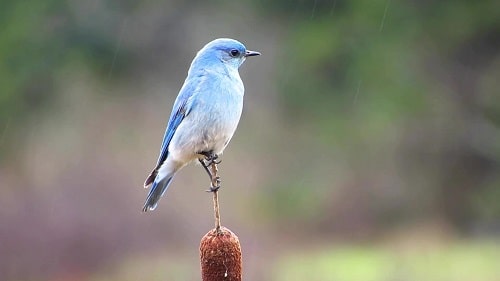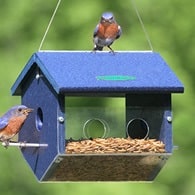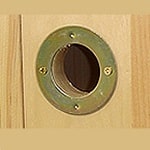Mountain Bluebird Mating, Unknown to Most
Just like their eastern cousins, the Mountain Bluebird is in a constant struggle for nesting sites. These birds have benefited by the placement of birdhouses.
Their song is Robin-like with a pitch slightly higher than the eastern species.

Description
Mountain Bluebirds measure about 6 to 7 1/2 inches in length. The male has bright blue all over.
The female is grayish. Her wings and tail are blue. The wings are longer than either the eastern or western bluebird.
Mating Habits
The mating habits include the male singing from exposed perches or from the tops of trees.
Serving two purposes, letting potential mates and rivalsknow that he has possession of that particular territory.
These birds begin singing at the first hint of daylight. As the day begins to shine, moments after sunrise, they stop singing.
Believed to be monagamous during the nesting season. Males aggressively defend their mates from other single males.
Nesting Habits
In order to attract Mountain Bluebirds to nest near would require a few things.
First, you need to be in their range which is at high elevations and latitudes in western North America that extend above timberline in the Rocky Mountains and north into the Yukon and Alaska.
Then you need an expanse of an open field with few trees near. Mountain Bluebirds will make use of properly built Bird Houses![]() .
.
The nest is a loose cup of stems and rootlets in an abandon woodpecker hole, tree cavity, or cavity in earth bank or among rocks on a cliff. Uses birdhouses.
| Mountain Bluebird Nesting Stats | |
|---|---|
| Eggs | 4 - 6 |
| Incubation | 14 days |
| Nestling Phase | 18- 21 days |
| Broods | 1 - 2 |
Only the female builds the nest but both male and female aggressively defend the nest.
The female lays 4 to 6 pale blue or white eggs. Incubation last about 14 days and is done by both male and female.
The young will leave the nest in 18 - 21 days after hatching.
1- 2 broods raised each season.
Feeding Habits
Mountain Bluebirds feed on insects and berries. Often hovering just above the ground hunting insects.
One habit of these birds is called ground sallying, briefly landing on the ground from a perch, snatching their prey and returning to their perch to eat.
Some of the vegetable matter that is eaten is, grapes, sumac seed, elderberry, and currants.
Predators
Predators include: Cooper's and Sharp-shinned Hawks, Owls, Raccoons, and tree climbing snakes.
More
Learn the Eastern Bluebird Habits
Find Gifts for Bluebird Lovers



